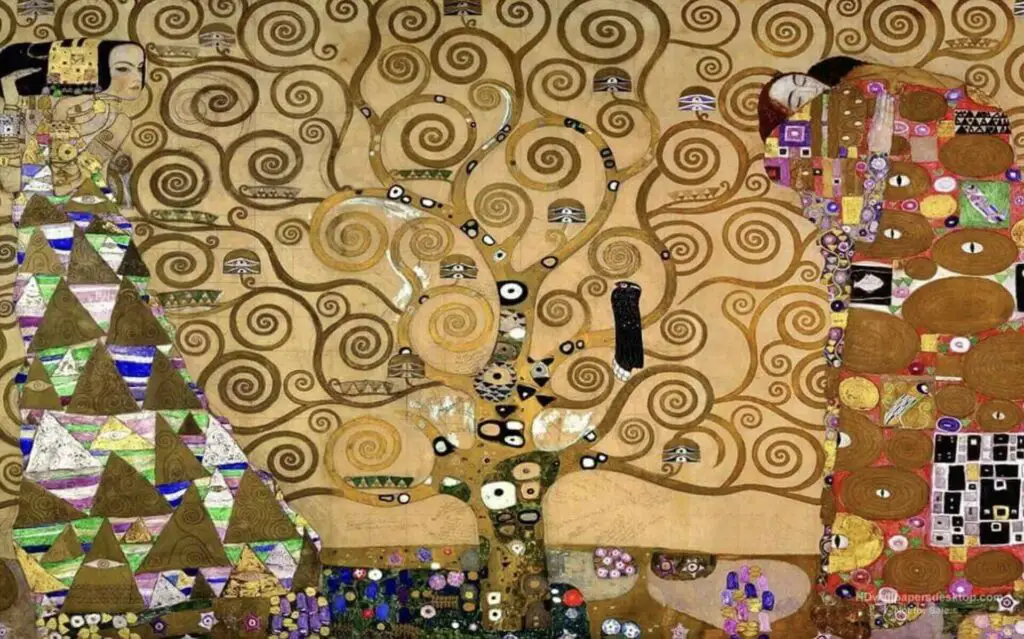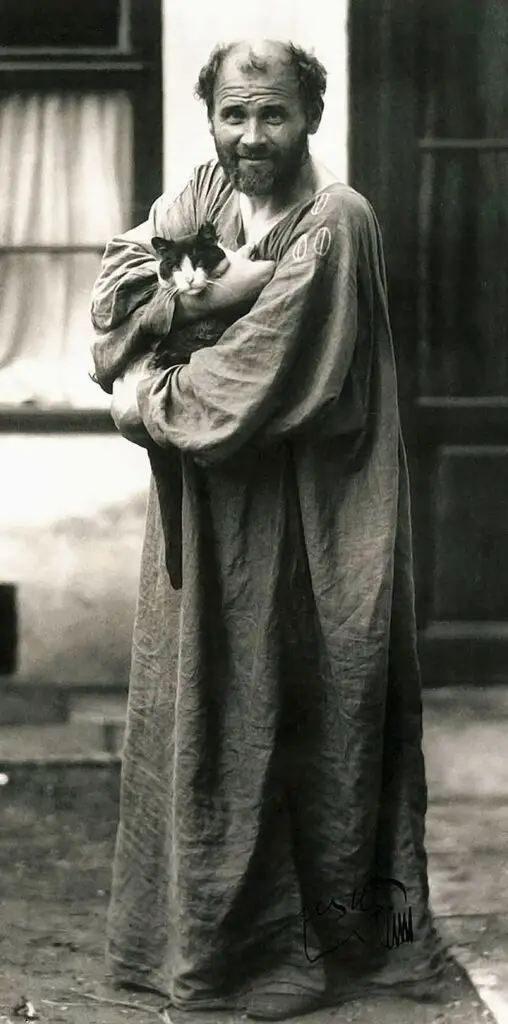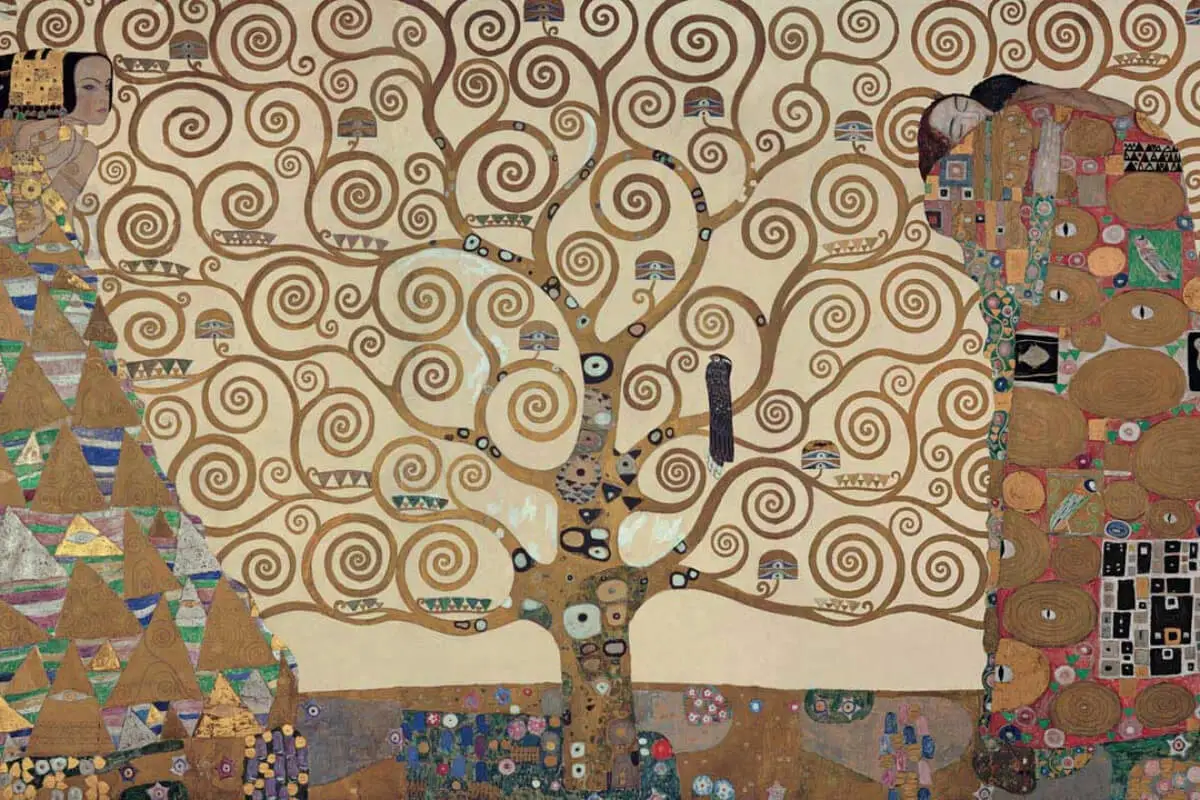At the turn of the 20th century, in an era of societal change and burgeoning artistic freedom, Austrian symbolist artist Gustave Klimt contributed an inimitable voice to the art world with his piece ‘The Tree of Life.’ This richly intricate painting, firmly rooted in the spirit of the Vienna Secession movement, mirrors the period’s unique aesthetic code and its decisive break from established art norms.
The Tree of Life, teeming with ornamental aesthetics, bristles with thought-provoking symbols and reflects Klimt’s profound commentary on life, knowledge, and human existence. Unraveling the intricate layers of Klimt’s work invites us to appreciate the artistic mastery and venture into a deeper understanding of Klimt’s era and his unique perspective.
Table of Contents
- Historical Context and Influence
- Symbolism and Interpretation
- Artistic Technique and Style of Klimt
- Related Questions

Historical Context and Influence
Art and history often go hand in hand, each reflecting and shaping the other in a cyclical dance. One artist who embodies this interconnectedness particularly profoundly is the Austrian symbolist painter Gustav Klimt. Klimt’s masterwork, “The Tree of Life,” is a perfect example of how an artist’s work is shaped by their era’s events, philosophies, and styles.
To understand the Tree of Life, one must first understand the era in which Klimt worked – the early 20th century, during the height of the Art Nouveau movement. Art Nouveau sought to break away from the rigid constraints of the past, combining decorated art with functional objects. It was a response to the rapidly industrializing world, an attempt to bring beauty into everyday life while rebelling against the mass-produced sameness that was increasingly prevalent.
Klimt was a noted member of the Vienna Secession, a group of artists striving to create a “total work of art,” or Gesamtkunstwerk. This group aimed to unite the different branches of the arts into one encompassing form. Inevitably, this ambitious endeavor led Klimt to blend various styles and mediums. This is observable in his “The Tree of Life.”
His artistic vision was also shaped by the aesthetic currents of his time, including Symbolism and Art Nouveau’s organic lines and flattened forms. The symbolic search for transcendence and the decorative richness of Eastern Mosaics influenced Klimt. Both these influences are markedly pronounced in his “The Tree of Life,” filled with symbolic, ornate, and brilliant-colored motifs.
The interpretation of the tree within a spiral – a never-ending process representing life’s cyclical nature – resonated with Egyptian and Oriental art and spiritualism, which interested Klimt. This tree is mystical, symbolic, and ornamental, encompassing Klimt’s profound exploration of the cycle of life, death, and rebirth, deeply entwined in mankind’s relationship with nature.
Notably, the socio-political context of Klimt’s era had immense effects on his work. The status of women in society was brought into acute focus, which we see in “The Tree of Life’s” portrayal of a simple, ordinary woman in the embrace of the tree, alluding to creation and prosperity.
Klimt created “The Tree of Life” amidst immense economic, social, and artistic changes. The painting reflects these currents, embodying an ambitious attempt to distill the complexity of life into a singular symbol and, with it, a deeper understanding of reality.
The painting is not just inspired by a moment in history; it successfully captures the essence of the era, and the admiration it garners even today speaks volumes about the universal themes it explores. With each analysis, viewers are reminded of how art itself is influenced by the circumstances of its inception – a testament to its enduring power and relevance.
Klimt’s “Tree of Life” is a significant reminder that historical context and influences are decisive in shaping artistic expression and reception. As such, art remains a potent avenue to navigate, understand, and appreciate the nuances of different eras and cultures.
Symbolism and Interpretation
Gustav Klimt’s “The Tree of Life” is rich with symbolism, each element woven by the artist into a stunning tapestry of life, love, and human connection. At the core of this spectacular artwork, the tree concept is archetypical – not just in art but in philosophy, religion, and natural science, and it holds immense symbolic power. As trees grow, they fluctuate between seasons. Similarly, our lives evolve through cycles of struggle, growth, and transformation – this is Klimt’s piece’s first and most potent message.
With its swirling branches and roots, the tree is skillfully designed to invite viewers into a deeper thought – a dance between life’s polarities. These branches, each with varied curves and spirals, meet at a focal point depicting an intimate pair, symbolizing the unification of male and female energies. This could also represent life’s dualistic nature – its joys and sorrows, victories and defeats, love and despair.
Delving into the roots of this magnificent tree, just like the roots of life, they plunge into the depths, echoing the intricate complexities of human existence. They are a poignant reminder of the interconnectedness of all life. As roots extract sustenance from the earth, we should draw strength and wisdom from past experiences.
A myriad of intricate details accentuate Klimt’s iconic patterning style. These details are fascinating, revealing many symbols when one looks closer—the discernible eye in a vibrant feather surely suggests the concept of wisdom. At the same time, the bird beside it probably signifies liberty.
Noticeably, the bold stripe pattern and the radiant golden hue of the mosaic-like backdrop, which was a pronounced Eastern influence for Klimt, starkly contrast the organic lines of the tree. This experiment with patterns, shapes, and colors intensifies the symbolic strength of the painting, echoing the dominant theme – life is full of contrasts.
Interestingly, strategically placed female figures are also distinctly symbolic in Klimt’s “The Tree of Life.” The lone figure on the left could represent anticipation, while the pair at the top signifies connection and communion. These figures further enhance the work’s narrative – life’s journey is about growth, yes, but it is also about our connections with others.
Klimt’s “The Tree of Life” is a testament to the interconnectedness of existence, the cyclical nature of life, and the profound duality embedded in our existence. Looking at the painting, viewers are given a chance to look beyond the palpable, to delve into the intricate and beautiful complexities of life. This masterpiece is not just a pictorial representation but a philosophical journey into the world of symbolism and interpretation. It is a timeless work that continues to captivate art lovers worldwide.

Artistic Technique and Style of Klimt
Gustav Klimt’s masterpiece, “The Tree of Life,” richly radiates an extraordinary blend of symbolism and archetypes. Every element, from organic forms and mosaic influences to strategically placed female figures, echoes Klimt’s signature style and innovative techniques. Art lovers and experts marvel at the intricate design elements, viewing them as a visual language transcending time and space.
Examining the tree concept underpinning the artwork uncovers its vast symbolic power within philosophy, religion, and natural science. The tree symbolizes life, growth, and connection to one’s roots in various cultures worldwide. In his painting, Klimt’s portrayal of this tree indicates his fascination with heralding universal truths and phenomena in his artistic creations. This universality enhances the painting’s compelling narrative, making it relatable across generations and cultures.
In the “Tree of Life,” Klimt masterfully expresses the cyclical nature of life and growth. The gracefully curved form of the tree, extending from roots to branches, reveals the artist’s ingenious portrayal of nature’s rhythm and flow. A cycle hints at birth, growth, death, and rebirth, reminding viewers of the relentless wheel of time where endings and beginnings are seamlessly intertwined.
Additionally, the dichotomy of life is represented through the tree’s branches and roots. The branches stretch upwards, reaching the heavens, symbolizing aspiration, growth, and enlightenment. Conversely, the roots dig deep into the earth, signifying grounding, strength, and the importance of remembering our origins. This duality in Klimt’s style beautifully captures life’s perennial contrasts: hope and despair, dreams and reality, ascent and descent.
Even more profound is the painting’s depiction of life’s interconnectedness. Klimt showcases that every form of life, no matter how small or significant, is interconnected and plays its role in the grand scheme of nature. The swirling branches connecting myriad elements signify how past experiences — with their wisdom and lessons — are intricately woven into our present and future fabric.
The myriad patterns and colors in Klimt’s “The Tree of Life” also embody an alluring mix of symbolism. For instance, the swirling branches are reminiscent of Van Gogh’s “Starry Night”, reflecting a fusion of artistic styles. Golden hues used liberally echo Byzantine art mosaics, further demonstrating Klimt’s adaptability and appreciation of other art forms.
Strategically placed within this captivating canvas are female figures, serving more than aesthetic appeal; they are crucial to the storytelling. Their inclusion embodies the feminine power to create and nurture life, bringing more profound meaning to this universal life cycle narrative.
The Tree of Life’s philosophical journey marks a bold departure from traditional art representation, crafting a timeless appeal. This symbolic piece encapsulates Klimt’s artistic vision, innovative techniques, and penchant for symbolism, which resonates with art lovers globally. Even after over a century, Gustav Klimt’s “The Tree of Life” continues to inspire, fascinate, and provoke thought, remaining a sterling example of art that stands the test of time.
Klimt’s Tree of Life intertwines the delicacy of human existence and the complexity of the artist’s worldview, making it a fascinating subject of study beyond the realms of art. Known for his unique style and unconventional techniques, Klimt offered a vivid exploration of life. Klimt’s elaborately patterned, exquisite compositions testify to his significant role in the Symbolist art movement.
From the swirling branches to the fantastical creatures, every stroke carries a philosophical echo, a compelling dialogue between the artist and the observer. A deeper understanding of Klimt’s Tree of Life thus enlightens us about the artist and the epoch he was part of, offering a rich, multifaceted lens to perceive the broader narrative of creative evolution.
Anita Louise Art is dedicated to art education, great artists, and inspiring others to find and create their art. We love art that uplifts and inspires. #ArtToMakeYouSmile! #ArtToMakeYouHappy!
If you want to see any of my art, you can find out more by clicking here. If you are interested in what inspires me and my paintings, you can discover more by clicking here.
We have a free newsletter and would love you to be part of our community; you can subscribe to the newsletter by clicking here. If you have any questions, I would be happy to talk to you. You can reach me, Anita, by clicking here.
Subscribe to our Anita Louise Art YouTube Channel, filled with great videos and information by clicking here.
Join us for our podcast “5 Minutes With Art.” Spend just 5 minutes a week with us to discover and learn about great art and artists. You can find out more about our podcast by clicking here.
Related Questions
Unlocking The Secrets Of Gustav Klimt’s Iconic Kiss
The Kiss is one of Gustav Klimt’s most celebrated artworks; it was painted from 1907 to 1908. The painting is filled with intricate details and gold leaf. The Kiss by Gustav Klimt depicts a couple locked in a passionate embrace, with the man kissing the woman on her cheek. The painting shows Gustav Klimt’s unique artistic style.
By clicking here, you can learn more by reading Unlocking The Secrets Of Gustav Klimt’s Iconic Kiss.
Gustav Klimt’s Paintings: An Intimate Glimpse Into His Genius
Gustav Klimt is widely regarded as one of the most influential artists of the 20th century. His innovative and daring approach to art and unique style and vision have made him an icon in modern art. Klimt’s paintings are celebrated for their sensuality, symbolism, and intricate details, which have captivated audiences for over a century.
By clicking here, you can learn more by reading Gustav Klimt’s Paintings: An Intimate Glimpse Into His Genius.
The Timeless Legacy Of Gustav Klimt’s Paintings
Gustav Klimt was a groundbreaking Austrian artist whose work continues to captivate audiences worldwide. His bold and innovative approach to art and his use of symbolism and sensuality have made him one of the most iconic artists of the modern era. Klimt’s legacy has profoundly influenced the art world and continues to inspire artists today.
By clicking here, you can learn more by reading The Timeless Legacy Of Gustav Klimt’s Paintings.

